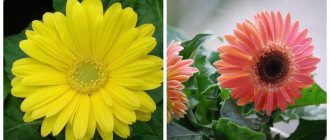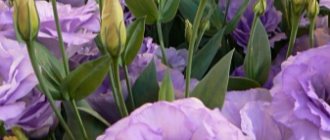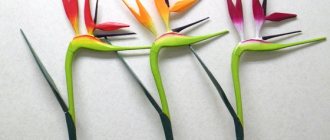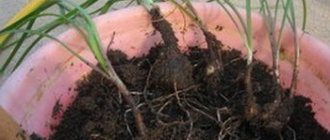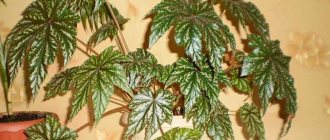Reproduction methods
Often after flowering the plant begins to propagate; this can be done in several ways:
- By seeds - it is rarely used, especially if it is a garden Gerbera, since more than 10 months pass from the moment the seeds are planted until the first buds appear. But if you sow seedlings in January, then by August you can get a lush flowering plant.
- By dividing the bush - in this case, choose a four-year-old plant. This is necessary so that there are two growth points left on each bush, otherwise the bushes may die.
- Cuttings - cut off a part of the stem that should have 2 leaves and plant it in the ground. Soil temperature is at least +20 degrees. To make the rooting process faster, you need to cover it with a jar or cut plastic bottle.
Read about how to propagate Gerbera and how to care for it at home.
We pick gerbera seedlings
Gerberas peak when young shoots produce a second rosette of leaves. All professionals say this. For this, pots, plastic cups or any other containers with a volume of 100 g are used. Drainage holes must be made in their bottom. Expanded clay is laid on the bottom. The soil used is the same as for planting seeds.
I had a slightly different situation. My first gerbera shoots from seeds did not have time to produce a second rosette of true leaves, but I still carried out the picking. Why? Because there was very little soil in the greenhouse (let me remind you that the first time I poured a layer of soil 3 cm high into the greenhouse. This turned out to be not enough). As a result, the roots of the seedlings began to intertwine and interfere with each other.
Let me remind you that gerbera has a very delicate root system. Any manipulation with it has a bad effect on the health of the plant as a whole. After picking, gerbera seedlings need gentle conditions. This is a temperature of +19...+23 degrees, moderate watering and high air humidity, the proper level of illumination. So, I picked the gerbera on February 26 (seeds were planted on February 2). For picking, I took 200 ml cups. A little less than half of the soil was poured (the amount of soil should be commensurate with the size of the root system). Why take a large plastic cup and fill it halfway with soil? You can take a small container for picking. The answer is simple. After picking, gerberas need increased air humidity. By covering a glass of gerbera with film, you can create a mini-wig for the plant.
After picking, cover the cups with gerbera with film and place them on the window. I have windows on the east side of the apartment, where the sun shines until 15.00. After sunset I turned on the artificial lighting. I have a phytolamp. It was on until 10 pm every day. I watered it rarely, since moisture evaporates slowly in the greenhouse.
After picking, gerberas need gentle care conditions. This is a temperature of +19...+23 degrees, a high level of air humidity (you need a mini-greenhouse), artificial lighting for 12-14 hours, moderate watering.
A month later, that is, March 29, my gerberas have grown somewhat. Some did not survive the picking, although the conditions of keeping the plants were the same. Based on my observations, I made a conclusion. It is necessary to disturb the roots of the gerbera as little as possible and carry out the first picking only when the gerbera has grown a sufficient amount of green mass (from 4 true leaves).
The seedlings were cared for as follows: the greenhouse was removed when the third rosette of leaves had grown sufficiently. The temperature was kept at +19…+23 degrees. Watering as the soil dries out, no fertilizing was carried out.
Read the continuation of the article about growing Jameson's gerbera from seeds at home. Second planting, personal experience, growing problems and their practical solutions.
Planting material
The seeds of the plant have an elongated shape with a small brush at the tip, small in size. One gram contains 300-500 pcs.
Gerbera is not a self-pollinating plant , therefore, in order to obtain seeds from a flower, it is necessary to carry out cross-pollination, artificial pollination at the time of flowering. Pollen ripens faster and is stored for 100 days.
It is worth remembering that in order to preserve the variety, both the male and female plants must be of the same species, otherwise you may end up with a plant with completely different characteristics. The result is unpredictable; the resulting seeds can produce a completely different plant in terms of characteristics.
Types and varieties
Gerberas are found in a wide range of colors; they are decorative and durable. For several decades, these plants have been among the most popular flowers. As already noted, previously it was possible to propagate them only in greenhouses, since they required greenhouse conditions (the plant comes from hot regions of the world), and the tall stems had to be protected from wind and drafts. But since dwarf varieties have also been created, they are grown in pots or directly in open ground. Gerberas are generally classified into two main groups, which were developed respectively from the two main South African species:
green leaf gerbera;
Gerberas are generally considered annuals. But if indoor varieties, after flowering and wilting, are left for one month without watering, and then irrigation and fertilizing are resumed, then the gerbera will again produce a stem, leaves and bloom. Although potted mini-gerberas do not have such large flowers (2-4 cm in diameter) as their greenhouse relatives, this does not mean that they are less attractive and charming. Moreover, we can choose from a number of extremely beautiful varieties of flowers of different colors, including white, pink, cream, burgundy, red, blue, blue, purple, yellow, mix, as well as with different inflorescences: single, double, full, needle, hybrid.
Gerbera Jameson is an ideal, if slightly forgotten, plant. Once cut, its flowers last up to 14 days. Gerbera has an inflorescence typical of asteraceae - baskets. It is a perennial plant that produces numerous random roots growing at the base or side of the shoot. The leaves are lobed, densely pubescent below. The flowers, typical of the Asteraceae family, are collected in a basket-type inflorescence. The petals are long and slightly bent, forming one or more curls. The color is very varied, but pastel colors predominate.
When do they ripen and how to harvest?
After successful pollination, the seeds of the plant will be ready for collection in a month, as soon as the center of the flower becomes fluffy. The flower is disassembled by hand and the seeds are removed. It is worth remembering that the seeds retain good germination only 6 months from the moment of collection , during which time they need to be planted in the ground. The price depends on the amount of seed in the bag. For example, 25 pcs. - 80 rubles, and 10 pcs. – 0t 22 to 40.
Important : When purchasing, look at the packaging period of the seed material; if it is more than 6 months, you should not buy such seeds, their germination rate is very low.
Conditions for growing at home
Among the preferences of gerbera are good lighting, high humidity, warm temperatures, and absence of drafts. Caring for indoor flowers is simple - you only need regular watering, fertilizing, sanitary pruning and replanting.
Location and lighting
In the room, the gerbera should be placed in the brightest place. The recommended location to achieve maximum decorativeness is a western or eastern window sill. When growing in a south-facing window, there is a high risk that the plant may get sunburned and be too hot.
Therefore, it is necessary to diffuse the light. It is not advisable to grow a flower from the north side. If there is no other option, then additional lighting is needed, which will extend the daylight hours to the required 10–12 hours.
Temperature and humidity
Indoor gerbera blooms well at temperatures of +20…+22°C. Higher temperatures lead to a decrease in the decorativeness of the plant and a deterioration in flowering. When an indoor crop does not bloom, the optimal temperature for it will be +14...+16°C.
Lowering the thermometer below +10°C is dangerous for a flower. Drafts and temperature changes are also harmful to it. When ventilating the room, it is better to take the flower to another room to avoid exposure to cold air currents.
Humidity for gerbera is needed above average - at the level of 60–80%. When the weather is hot outside, you need to spray with a spray bottle. In this case, it is not the flower itself that needs to be moistened, but the space around it, since moisture getting into the rosettes of leaves and on the petals can lead to the development of diseases, burns and the appearance of unsightly spots.
Read more about caring for gerbera in a pot at home.
You can maintain the desired level of humidity by placing the pot on a tray filled with moistened pebbles and expanded clay. Another way is to purchase and install an air humidifier in the room.
Features of cultivation
To grow a beautiful, strong plant from a seed that will delight you with friendly flowering, you need to know the nuances of planting and subsequent care. We talked about what to avoid when growing Gerbera in pots in this material.
Sowing time
You can sow seeds at any time, starting from the moment the seed is collected . But, in order not to contradict the nature and biorhythms of the plant, it is better to plant in spring. Preparation for cultivation: soil and seeds.
Soil preparation
Gerberas love porous and light soil, which is prepared from 2 parts leaf humus, 2 parts peat and 1 part washed river sand. In this case, the soil should be neutral or slightly acidic. Before planting, the soil is disinfected by sprinkling it with a solution of potassium permanganate, the temperature of which is +50 degrees. There is no need to do anything to prepare the seeds; sowing is carried out without soaking, and they do not need any processing.
Landing rules
The flower seeds are very small, and there is no need to dig them deep into the soil ; just scatter them over the surface and sprinkle them with peat. The soil must be moist. For rapid germination, it is worth providing the planting material with certain conditions, creating a greenhouse effect.
To do this, cover the container with glass or film. The first shoots will appear in a week, but every day you need to remove the covering material for ventilation. As soon as the seeds germinate, the glass is removed.
The optimal temperature for germination is +20 degrees. Gerberas can be sown in a small container, or in separate peat pots ; this will be much preferable, since subsequent replanting into the pot will not damage the root system.
Watch a video about planting Gerbera seeds:
Choosing a pot
As soon as 3 true leaves appear on the Gerbera seedlings, it can be transplanted into a separate pot. Take a small pot - if the plant has too much space, it may not bloom.
The seedling is placed in a 700 ml clay pot. A large layer of drainage should be placed at the bottom of the pot .
Tip : Despite the fact that Gerbera will grow well in a clay container, transplanting it into a plastic pot is much preferable, since you can water the plant in a tray.
How to grow gerberas from seeds?
These flowers have been known as an ornamental crop since the mid-18th century. In 1737, they were first described by the Dutch scientist Jan Gronovius. He decided to name the new species in honor of his colleague, director of the Moscow Botanical Garden Traugott Gerber.
Now many varieties of this plant have been bred: large and dwarf, regular and double, with different diameters, colors, and shapes of petals. Modern hybrids come in all shades except blue, indigo and purple. Only artificially colored white daisies can be like this.
german-federal-horticultural-show-1061761_1920-2.jpg
You can buy gerbera seeds in flower shops or specialized shops, but you should pay attention to the expiration date of the material. Sowing can be done at any time, but since the emerging sprouts need as much heat and light as possible, it is better to do this in mid-March - early April, with a noticeable increase in solar activity.
4.jpg
In order for a healthy gerbera to grow indoors, when to sow seedlings, everyone decides for themselves. If it is possible to supplement the light and warm the young shoots artificially, the timing is absolutely not important - in greenhouses this procedure begins even in winter, and after 10-12 months the first flowering begins.
Caring for an indoor flower
In order for a plant to grow healthy and capable of flowering, you need to follow certain care rules:
- The plant in the active growth phase needs to be provided with a comfortable temperature - 18-24 degrees. As soon as Gerbera begins its dormant period, after the end of flowering, it is transferred to a cool place with a temperature of 14 degrees.
- When growing seedlings in winter, they need to be provided with additional lighting. If the plant does not have enough light, the seedlings will stretch out and be weak.
- As soon as the plant blooms, it is provided with 12 hours of daylight. This is due to the fact that Gerbera blooms at the end of summer, when daylight hours begin to wane. The plant is photophilous and responds very well to intense sunlight. If you want to prolong flowering in winter, provide good lighting, and the glow should be warm.
The dormant period begins when the plant stops blooming and lasts 3-4 months.- Air humidity is very important for the plant. But you cannot spray Gerbera with water - a fungal infection appears. To humidify the air, spray water around the plant, or pour pebbles into a tray and pour water into it, which should not touch the bottom of the pot.
- This is done as follows: place the pot with the plant in water for 10 minutes, then return it to the pebbles.
- Gerbera requires replanting every year into a container that will be 1-2 cm larger than the previous one. If you buy a soil mixture in a store, then select soil for planting roses (how and when to replant Gerbera after purchase?).
- 2 weeks after transplanting the seedlings, you can start feeding. For this purpose, only complex mineral fertilizers are used for flowering crops. During the growing season, fertilizing is carried out every 14 days.
- If the soil for planting is prepared correctly, then the amount of nitrogen fertilizer required for the plant is present in it. If you overfeed a Gerbera, it will begin to grow green mass and will not bloom (you can find out why indoor Gerberas do not bloom and how to care for them here).
- During the dormant period, it is important to provide the plant with comfortable conditions. Reduce watering to a minimum, lower the temperature to +14 degrees. It is necessary to water when the top layer of the earthen clod dries. No feeding is carried out at this time.
How does a plant reproduce?
Indoor gerbera is a short-lived plant; it needs to be renewed every 3-4 years.
Every gardener wants to preserve beautiful plants for as long as possible using various propagation methods. This is not difficult to do, especially when you want to save the flower you like.
Recently, many garden flowers have been grown on windowsills.
“Bouquets in pots” are very fashionable and stylish, and they also please the eye much longer. So there is nothing complicated in caring for indoor gerberas .
Even a novice gardener can, by providing the flower with optimal home conditions, achieve bright and abundant flowering. This article describes in detail the propagation of gerberas in all possible ways.
What time of year is best to carry out the procedure?
Street gerberas are propagated by seeds only in the spring. Sowing of seedlings can be done as early as March . Unlike outdoor indoor gerberas, you can grow them using this method at any time of the year.
Gerbera roots are African, so the summer of central Russia is quite suitable for the flower, but there should be no temperature changes between day and night.
But in cold autumn and frosty winter, gerbera is not able to survive the winter . If the plant is not dug up in time, it will die and next spring you will need to start planting a new plant again.
Therefore, the Russian climate is not suitable for growing gerberas all year round. In such climatic conditions, the flower is best grown in greenhouses or flower pots. Residents of warm regions in mild winters can cover the roots of gerberas with fallen leaves or straw.
Gerbera blooms all summer. Bright colors decorate the space for 3-4 months. But this period may vary, it all depends on the characteristics of the variety or hybrid.
Watering
The plant is moisture-loving and needs abundant, timely watering during the period of active growth. But you don’t need to make a swamp in a pot either. It is advisable to water Gerbera only through a tray , since water entering the bush and shoots can cause the development of fungal diseases (read about how to recognize and treat diseases of indoor Gerbera here). It is also worth remembering that watering is carried out only with warm water. Cold liquid can cause root rot and the spread of fungus.
How to water young shoots?
The seedlings are watered moderately, but at the same time avoiding the addition of a clod of earth. Moisture should not get on the plants, so it is better to use a syringe or syringe and inject water directly into the soil. Experienced gardeners often use an old steamer for watering.
Botanical certificate
Gerbera is a native of Africa that belongs to the aster family . This plant was discovered and described in the 18th century by the Dutch botanist Jan Gronovius, who also named it in honor of the German botanist Traugott Gerber.
It is also found in nature in Asian countries, Australia and Japan. Many people compare this flower with chamomile or cornflower. In my opinion, it looks like a small sunflower. The dark core is framed by many elongated oval petals. Coloring in white, yellow, orange, pink, red and purple tones. Only the blue color variation is missing.
The flower is located on a long leafless stem. The diameter of the flower basket is from 4 to 30 (!) cm. The leaves grow from the ground. The shape resembles dandelion leaves - elongated with irregularly shaped, as if torn, edges. The length of the leaves reaches 35 cm. The height of the bush is up to 60 cm.
The main use of this plant is growing for cutting for sale , making bouquets and flower arrangements. Dwarf varieties are successfully used in indoor floriculture. Find out how to keep cut gerberas in a vase for as long as possible here.
Landing
A relatively large amount of planting material can be obtained in a fairly short time through generative propagation of gerberas. Of course, we get plants that are slightly different from each other and require intensive selection. This method is often used for breeding indoor varieties. To produce seeds, flowers must be artificially pollinated. Gerbera seeds are quite large (220-400 pieces / 1 g) and germinate best immediately after they are collected. Treated seeds germinate in the dark at 20 degrees for 7-10 days, and after about 3 weeks (the appearance of the first true leaves), the seedlings should be pruned individually in pots. When 2-3 leaves appear on the plant, you can transplant it to a permanent place. The sowing date depends on the cultivation method and the planned harvest date. The growing period for seedlings lasts about 12-15 weeks.
The most common method is vegetative propagation of these flowers.
Currently, in vitro (behind glass, in a test tube) is an important method of breeding greenhouse plants. The method allows you to obtain a large number of identical plants without diseases, but this requires special equipment and a laboratory.
Work process - remove the mother plants from the ground and thoroughly wash the root bulb. Next, you need to cut the leaf blades, shorten the roots and remove the shoots of the inflorescence. Use a knife to cut the root into fragments
After decontamination in a solution, such as foundation, the plants should be planted directly in the target growing location.
After carefully tearing off all the leaves and flowers, the mother plants are placed next to each other in a multiplier so that the root collar is 2-3 cm above the ground surface. The soil should be slightly calcareous and nutrient-enriched with peat.
It is necessary to maintain the air temperature at least 25 degrees and high soil humidity (80-90%). After about 7-10 days, new shoots begin to grow from the buds. And after about 3 weeks, when the third leaf appears, the seedlings can be collected.
Mother plants are used for about 3 months, collecting seedlings three times. From one such plant you can get an average of 20-50 seedlings. The seedlings are placed in a permeable and sterile substrate and provided with conditions similar to those needed to produce shoots. After 2-3 weeks, root formation begins. The period of production of seedlings until they are planted in a permanent place takes about 5-7 weeks.
Planting is carried out in two periods: in the summer (June-July) for autumn-winter flowering, and also in March for summer flowering. The planting interval is 20x30 cm for one-year cultivation, 30x30 cm for two-year cultivation. After planting, typical care procedures are applied - watering, protection and maintaining appropriate temperature and humidity. Special procedures for growing are reduced to the following operations.
- Removing inflorescence shoots is carried out first after planting the gerbera in a permanent place in order to strengthen the vegetative part of the plant. This delays flowering but affects the quantity and quality of flowers. Flowers are also removed before the rest period.
- Plant cleaning is the removal of old leaves, which gradually turn yellow and dry out, which limits the development of fungal diseases. Treatment must be repeated every 2-3 weeks.
- Rest - used for two-year cultivation. This involves gradually limiting watering and fertilizing (in November-December) and lowering the temperature to about 15 degrees above zero.
Interesting facts and funny coincidences
It's amazing how unexpectedly objects and concepts with the same name can intertwine in our lives. So we meet gerberas not only in the flower shop.
In the vastness of one of the republics of the Russian Federation, a holiday dedicated to the end of sowing work is held annually. Thus, “Gerber 2015” was held in Udmurtia on June 20. This is a national holiday of the republic, celebrated for many years.
Since this is a German surname, it also appears in the names of various companies. The famous knives of this brand, which once actively provided weapons in the army, are now successfully used in the home.
The daughter of the famous model Cindy Crawford also bears the surname. Sixteen-year-old beauty Kaya continued her mother's profession and confidently shines on the best catwalks in the world. She got her last name from Randy, Cindy's husband, with whom she had two children. The girl's first photos as a model appeared at the age of 10, when she made her debut at Donatella Versace's modeling show, becoming the face of the fashion house in the Young Versace category.
Artists didn’t pass by the gerberas either. We can meet them in pictures and postcards for a variety of holidays. They look especially amazing on birthday cards.
Plants in bouquets and compositions
Florists value the sunny flower for its amazing ability to look great in the most unexpected bouquets. Look how beautiful this amazing bouquet of gerberas and chrysanthemums is, compiled according to all the laws of floristry.
Professionals say that these flowers are appropriate for any celebration. Snow-white varieties are perfect for making a bridal bouquet, and fiery flowers will be a pleasant revelation for your loved one. Terry pink gerberas will highlight the beauty of the young princess, and a multi-colored bouquet will bring joy to the hero of the day.
The average price of one flower is 100 rubles, but there are also expensive varieties, with double flowers and rare shades. In some cases, the price per piece reaches 250 rubles.
The undoubted advantage of the flower, along with its appearance, is its durability: when cut, they can last in water for more than a week.
Tip: do not pour a lot of water into the vase, just cover the stem a few centimeters for the flowers to last a long time.
Post-procedure care
You need to be very careful when propagating gerberas - even a small mistake can ruin all your efforts. This plant comes from the tropics, so it is important to create similar conditions for its growth and development.
Attention! Do not overdo it with moisture, since the plant is very weak and needs a special microclimate.
Self-care and reproduction are very simple. Caring for different types of gerbera is the same, but it also has some difficulties - protect the plant from direct sunlight. In spring it can be kept in a pot of gerbera on a glassed-in balcony.
In winter, you cannot do without additional light , since flowering depends on it. Flowering is especially abundant in autumn, and in summer there is a dormant period - the flower is actively gaining green mass.
We recommend that you read our other articles that will help you avoid mistakes when growing gerberas at home:
- When and how to replant a flower after purchase?
- Diseases and pests of indoor plants.
- Why do the leaves turn yellow?
Choosing a pot
Your beauty has grown from a seedling state and already has a few true leaves. It's time to think about transplanting into a separate pot. It should not be too large, otherwise you may not see flowering. At the initial stage, a container with a volume of 700-800 ml will be suitable.
Gerbera feels best in a clay pot. A layer of drainage material must be laid at the bottom.
However, the advantage of plastic dishes is that the most optimal method of watering is possible - through a tray.
Know-how - in vitro propagation
This method involves growing gerbera seedlings in plastic or glass closed containers, which promotes the formation of healthy plants and protects them from diseases and pests during the initial growing season. This method is the most labor-intensive and requires experience in growing plants in laboratory conditions.
The entire in vitro cycle consists of several stages:
- selection of microcuttings;
- sterilization of planting material;
- placing explants in a nutrient medium;
- propagation of microclones;
- adaptation of seedlings;
- planting and growing plants in flower containers.
One gerbera can grow up to forty million specimens.
Reproduction by dividing the bush
Gerbera is whimsical about this method of breeding. Propagation by dividing the bush is acceptable only for four to five year old plants with a strong root system. It is performed in early March.
The flower, along with the roots, is carefully removed from the container in which it grew or overwintered (if we are talking about flowerbed varieties), and is divided into several parts, cutting the soil segments filled with roots, previously treated with a sterile knife. Cuts are made on the shoots of each segment, leaving four petals on them, and the cuts are treated with crushed coal.
Each part of the flower is planted in a separate container, and the plants are provided with proper care - ventilation, watering, fertilizing. Active growth of plots begins after one month.
Propagation by cuttings
Gerbera tends to reproduce by cuttings. This is the most affordable and most successful method of growing gerbera. This propagation is carried out in the spring. To form a cutting in early April, when the flower produces young leaves, you need to carefully separate the part with two leaves and roots from the shoot. Prepared cuttings should not be higher than five centimeters; they are planted in flower containers. To create a greenhouse effect, they are covered with plastic cups or film. The planted cuttings are kept until rooting at a temperature of + 21 ... + 25 ° C.
Diseases and pests of gerbera
Gerberas, like other indoor and garden crops, often suffer from pest attacks. Often flowers begin to hurt due to parasites and improper care. Gerberas are quite sensitive plants, so it is necessary to carry out preventive and protective measures in a timely manner.
So, the most common problems that gardeners face when growing gerberas are the following:
- Mosaic. A most dangerous virus that destroys both flowers and vegetable crops. It appears as white or green spots on the leaves of flowers. Folk remedies and even chemicals will be ineffective in the fight against mosaic. It is necessary to adhere to preventive measures: treat the seeds before sowing, clean the soil, spray the plants with fungicides. It is better to simply trim off the affected areas carefully. If the disease has not gone too far, you can use Aktara or Actellik.
- Powdery mildew. This disease is very dangerous and develops quickly. Most often, plants are affected by powdery mildew during the summer heat. The disease is caused by fungal spores. It is not at all difficult to notice the manifestations of powdery mildew: a white coating appears on all parts of the plant. It is better to fight the disease with fungicides. Excellent options are “Skor”, “Fundazol”, “Topaz”. Use strictly according to instructions.
- Root rot. Due to the disease, flowers may die. There are several causes of root rot. Firstly, planting plants in unprepared soil that is infected with pathogenic fungi. Secondly, there is an excess of moisture in the ground, stagnation of liquid. An excellent preventative agent is the Previkur Energy fungicide, which also has a stimulating effect. Treatment with special means alone will not be enough; it is also necessary to improve the drainage of the soil and follow the rules of watering.
- Gray rot. The disease occurs due to frequent rains or due to excess moisture as a result of frequent watering. Good preventive and therapeutic agents for gray rot are contact and systemic fungicides. They should be used according to the instructions on the package. During spraying, do not allow the preparations to come into direct contact with the buds. Fungicides “Switch” and “Horus” are effective.
- Whitefly. A pest that often attacks gerberas. Small white butterflies suck nutrients from the plant, causing irreparable damage to the flowers. Pests are very prolific, which complicates the process of exterminating them. You should choose drugs that kill both adults and their larvae. Aktara and Mospilan are good options.



